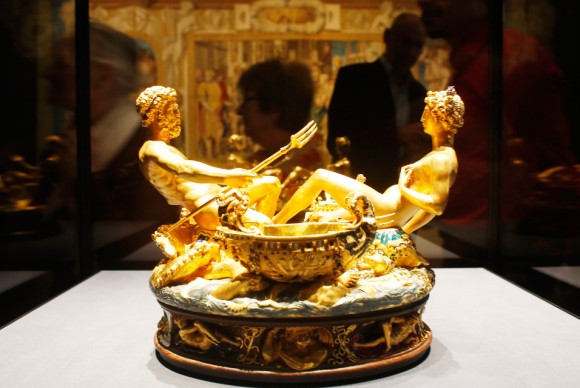Kunstkammer opens after restoration with exhibition of treasures from the Habsburgs
March 3, 2013 by All Art News
Filed under Art Events & Exhibitions, Featured
VIENNA.- The Kunst- und Wunderkammern (arts and natural wonders rooms) of the Renaissance and Baroque periods were encyclopaedic, universal collections that attempted to reflect the entire knowledge of the day. Particularly desirable were rare, curious and unusual objects. Thus princes and kings collected exotic and uncommon materials, to which they often ascribed magical powers, such as precious stones, ostrich eggs, coral and shark’s teeth, which were considered to be dragon’s tongues. From these natural products, artists created virtuoso works of art.
The Kunstkammer Wien is unique in the world. Its objects are of extraordinary quality, given the fact they were commissioned or purchased by the emperor or members of the imperial family.
Among the highlights in the Kunstkammer Wien are outstanding works of the goldsmith’s art, such as the famous Saliera by Benvenuto Cellini, first-rate specimens of sculpture, such as the Krumau Madonna, masterly bronze statuettes, filigree and bizarre ivory objects and virtuoso stone vessels as well as precious clocks, complicated automatons, remarkable scientific instruments, precious games and much more.

People visit the art-chamber (Kunstkammer Wien) of the art-historic museum (Kunsthistorisches Museum) on February 28, 2013 in Vienna on the eve of its reopening. The Kunstkammer Vienna – newly renovated and enhanced – is returning to the Kunsthistorisches Museum Vienna after 10 years, featuring goldsmith work, bronze, ivory and wood sculptures, and exotic objects such as ostrich eggs, the horn of the legendary unicorn, and the golden Saliera by Benvenuto Cellini. AFP PHOTO / DIETER NAGL.
History of the collection
Individual collectors from the House of Habsburg, who generally commissioned works as well, played a decisive role in expanding the holdings. The following collections provided the basis for the Kunstkammer Wien today:
The Kunst- and Wunderkammer (arts and natural wonders room) of Ferdinand II of Tirol (1529-1595). These objects were first displayed at Ambras Castle near Innsbruck. The collection also includes most of the objects that have been preserved from the older collections of the emperors Friedrich III, Maximilian I and Ferdinand I.
The Kunstkammer (cabinet of art) of Emperor Rudolf II (1552-1612), which he assembled in Prague. Many of Rudolf’s treasures were stolen when Prague Castle was plundered during the Thirty Years’ War, but many outstanding works of the goldsmith’s and lapidary’s art dating from around 1660 as well as masterly bronzes had earlier been taken to Vienna, where they enhance the collection today.
In the 17th century the holdings of the Kunstkammer of Archduke Leopold Wilhelm (1614-1662) were added to the collection. He was the brother of Emperor Ferdinand III and regent of the Netherlands. While he is seen primarily as one of the fathers of the Picture Gallery, along with his large collection of Italian paintings he also collected exquisite Renaissance bronzes and small sculpture in stone and wood.
Finally, in the 17th century the Vienna Treasury, originally the oldest of the Habsburg Kunstkammer, saw the addition of works of semiprecious stones, which were still very popular at the Vienna Court, as well as objects of turned ivory, carvings of rhinoceros horn and miniature wax models.
To protect it from Napoleon’s troops, the Ambras collection was brought to the Lower Belvedere Palace in Vienna, where it initially remained an independent collection. It was not until 1875, under the reign of Emperor Francis Joseph I, that a large reform of the imperial collections was undertaken. All of the various holdings were brought together at the Kunsthistorisches Museum, which opened in 1891, leaving only those objects in the Treasury that had the character of insignia or that were souvenirs of members of the imperial family.
The new collection, displayed on the mezzanine level of the building, was initially called the “Collection of Art Industrial Objects”. In 1919 it was given the equally inappropriate name “Collection of Sculpture, Arts and Crafts”. Because the holdings included few large sculptures and practically no utilitarian arts and crafts items, a decision was made in 1990 to rename it the Kunstkammer.
The collections enjoyed a high reputation as early as the 16th and 17th centuries. Any number of European potentates considered to an honour to contribute to the magnificence with gifts of their own. Starting in the 18th century, the artistic ambitions of the House of Habsburg turned increasing towards architecture, music and theatre. Later, the reorganisation of the collections and the construction of the Kunsthistorisches Museum were the focus of interest and effort, but important individual items continued to be added to the collection.
After the collapse of the monarchy in 1918, the collections of the House of Austria-Este were integrated, and in 1921 the collection of tapestries, which up to that time had been administered by the furniture depository, was added to the collection. It included almost 800 wall tapestries that originally served to decorate the imperial palaces. This collection is one of the most important of its kind, surpassed only by that of the Spanish crown. Only a short time before the Anschluss in which Nazi Germany annexed Austria in 1938, the estate of Gustav von Benda enhanced the collection with a number of exquisite major works of the early Florentine Renaissance period. The collection survived the Second World War with minimal losses. Particularly sad, however, were a number of tapestries that were lost while on loan to exhibitions in Berlin and Karin-Hall.
Since 1963 the holdings in the collection have again been reunited in the Kunsthistorisches Museum. In 2002 the Kunstkammer had to be temporarily closed for structural and technical renovation. Fundamental restoration and expansion of the spaces as well as a redisplay and modern presentation of the objects will raise awareness of the immense importance of this precious collection.
